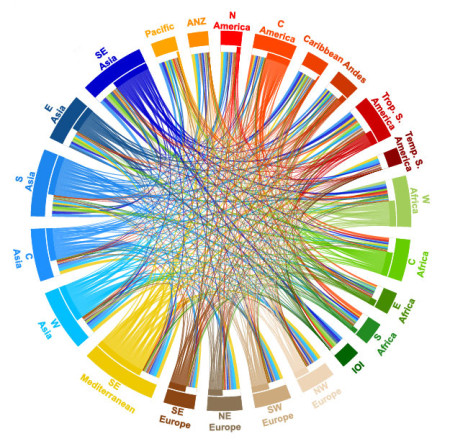A bunch of the usual suspects have just come up with an updating of an oldish study of global interdependence for crop diversity. I could describe the details here, but, frankly, Neil Palmer does it better than I ever could over at CIAT’s blog. And under a much better title than I can come up with. But to whet your appetite, here’s the money infographic, showing where different crop originated, and where they are now grown and consumed.

It’s all for the meeting of the Governing Body of the Plant Treaty, which is on next week.
LATER: Compare and contrast.
I always have fun reading stuff out of FAO on crop introduction. This one, and the Palacios one before it, and as expected, do not mention my 1988 paper*, written out of CIAT, nor the earlier Jennings and Cock (also CIAT) that explains a mechanism (as did Purseglove before them – escape from co-evolved enemies). I was not the first to quantify crop introduction. This was done by Kloppenburg and Kleinman in 1986 (these authors are cited in this paper) but they too, as with this one, missed the probable explanation. And the explanation I gave is important to the future of the Treaty. Countries hanging on to the `own’ genetic resources are playing `dog in the manger’: blocking access to a resource less valuable to the dog than to the horse.
The lesson is that the genetic resources and crops of other countries are more valuable to you than your own crop varieties. Proof: The USDA Plant Introduction (PI) system – now misnamed Plant Inventory – the basis for the USA crop production (and massive crop exports). Collectors went everywhere, got everything good, and tried it all out nearly everywhere in the USA: hit and miss, but the hits were enormous.
The Treaty should have firmly pushed crop introduction from the word go as a keystone concept. Also the `escape from enemies’ idea has an environmental bonus: farmers need far less spraying to kill the bad indigenous biodiversity associated with indigenous crops. Probably too late to help the Treaty now but the CG plant breeders can go on doing a good job.
*D. Wood 1988 Introduced Crops in Developing Countries: a Sustainable Agriculture? Food Policy 3(2):167-172
Me again: sorry.
I complained that the Khoury et al. report for FAO did not get beyond the figures for crop introduction to discuss the mechanism for the value of introduced crops (the idea of `escape from co-evolved pests and disease’). On closer reading I have another gripe about the Khoury et al. report, this time less their problem – it is one of the citations. The report cites (ref. 5), with apparent approval, the dreadful Zhu et al. 2000 paper (Zhu et al. 2000 genetic diversity and disease control in rice. Nature 406: 718-722). This claims: “Crop heterogeneity is a possible solution to the vulnerability of monocultured crops to disease.” and concludes: “Our results support the view that intraspecific crop diversification [varietal mixtures] provides an ecological approach to disease control that can be highly effective over large area and contribute to the sustainability of crop production”.
As with the Khoury et al. report on crop introduction, there is something a bit superficial in these claims in Zhu et al.. It is not the diversification per se that provides disease control in the Zhu et al. experiments, but clearly the effect of `herd immunity’ – a concept that seems alien to any general discussion by the genetic resource community on the value of diversification in cropping and ignored by Zhu et al.. But we are missing something important.
Herd immunity is a key concept in immunisation and vaccination for communicable diseases in human and animal health. It is measured as a percentage: “H, herd immunity threshold defined as the minimum proportion to be immunized in a population for elimination of infection”. (Fine, P.E. M. 1993. Herd immunity : history, theory, practice. Epidemiologic Reviews 15:265-302, p. 268). There is a vast literature.
Note that this is `elimination’ from the population – not just disease reduction. For a range of human diseases the herd immunity ranges from 75 to 99% (this latter an outlier for malaria). The mean is about 85% which need to be resistant for the population to attain immunity.
Zhu et al. easily got to the `herd immunity’ level with their experimental design for varietal mixtures of rice. Without understanding the concept, for the `immunized’ variety they used one or other of Shanyou hybrid rice with resistance to blast (that is, a result of modern plant breeding and seed production technology). The local (glutinous, preferred) varieties –susceptible to blast –were mixed in rows with the one or other of the Shanyou varieties at a rate of 9.2 and 9.7% of the Sahnyou varieties. That is, the resistant varieties (`immunized’) were 90.8 and 90.3% of the population. At this level there was herd immunity: the blast susceptible landraces were protected.
Towards the end of their paper Zhu et al. go on and on about the value of mixtures for disease control – obviously impressing Khoury et al. But the take-home message has been missed (by us all). Modern, disease-resistant varieties can eliminate disease regionally and allow the persistence of viable patches of traditional but susceptible varieties.
The research problem now is to determine just how big these patches of susceptible landraces can be before `herd immunity’ breaks down (under varying conditions and different crops). It has not escape my notice that the concept of `herd immunity’ has important implications for in situ conservation.
I need a beer.